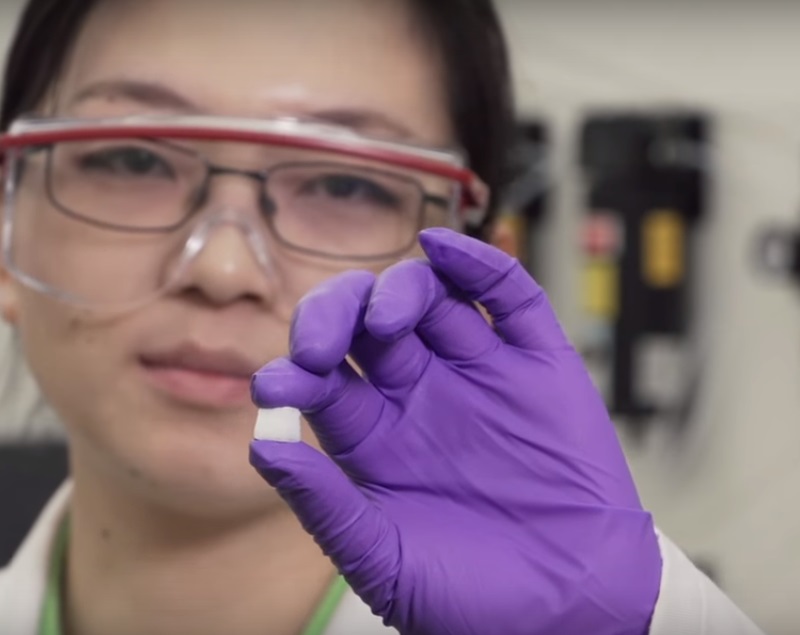- Home
- Science
- Science News
- New Self Adaptive Material Heals Itself, Stays Tough: Study
New Self-Adaptive Material Heals Itself, Stays Tough: Study

The material created by researchers at Rice University in Texas, US combines self-healing and reversible self-stiffening properties.
Called SAC (self-adaptive composite), the material consists of what amounts to sticky, micron-scale rubber balls that form a solid matrix. The researchers made SAC by mixing two polymers and a solvent that evaporates when heated, leaving a porous mass of gooey spheres.
When cracked, the matrix quickly heals, over and over. Like a sponge, it returns to its original form after compression. Researchers suggest that SAC may be a useful bio-compatible material for tissue engineering or a lightweight, defect-tolerant structural component.
"Other 'self-healing' materials encapsulate liquid in solid shells that leak their healing contents when cracked. Those are very cool, but we wanted to introduce more flexibility," said Pei Dong from Rice University.
"We wanted a biomimetic material that could change itself, or its inner structure, to adapt to external stimulation and thought introducing more liquid would be a way. But we wanted the liquid to be stable instead of flowing everywhere," said Dong.
In SAC, tiny spheres of polyvinylidene fluoride (PVDF) encapsulate much of the liquid. The viscous polydimethylsiloxane (PDMS) further coats the entire surface.
The spheres are extremely resilient as their thin shells deform easily. Their liquid contents enhance their viscoelasticity, a measure of their ability to absorb the strain and return to their original state, while the coatings keep the spheres together. The spheres also have the freedom to slide past each other when compressed, but remain attached.
"The sample does not give you the impression that it contains any liquid. That is very different from a gel," said Lou.
"This is not really squishy; it is more like a sugar cube that you can compress quite a lot. The nice thing is that it recovers," Lou added.
Making SAC is simple, and the process can be tuned - a little more liquid or a little more solid - to regulate the product's mechanical behaviour, researchers said.
The polymer components begin as powder and viscous liquid. With the addition of a solvent and controlled heating, the PDMS stabilises into solid spheres that provide the reconfigurable internal structure.
In tests, scientists found a maximum of 683 percent increase in the material's storage modulus - a size-independent parameter used to characterise self-stiffening behaviour. This is much larger than that reported for solid composites and other materials, researchers said.
The findings were published in the journal ACS Applied Materials and Interfaces.
For the latest tech news and reviews, follow Gadgets 360 on X, Facebook, WhatsApp, Threads and Google News. For the latest videos on gadgets and tech, subscribe to our YouTube channel. If you want to know everything about top influencers, follow our in-house Who'sThat360 on Instagram and YouTube.
Related Stories
- Galaxy S24 Series
- MWC 2024
- Apple Vision Pro
- Oneplus 12
- iPhone 14
- Apple iPhone 15
- OnePlus Nord CE 3 Lite 5G
- iPhone 13
- Xiaomi 14 Pro
- Oppo Find N3
- Tecno Spark Go (2023)
- Realme V30
- Best Phones Under 25000
- Samsung Galaxy S24 Series
- Cryptocurrency
- iQoo 12
- Samsung Galaxy S24 Ultra
- Giottus
- Samsung Galaxy Z Flip 5
- Apple 'Scary Fast'
- Housefull 5
- GoPro Hero 12 Black Review
- Invincible Season 2
- JioGlass
- HD Ready TV
- Laptop Under 50000
- Smartwatch Under 10000
- Latest Mobile Phones
- Compare Phones
- Huawei Pura 70 Pro+
- Huawei Pura 70 Ultra
- Tecno Camon 30 Premier 5G
- Motorola Edge 50 Fusion
- Oppo A1i
- Oppo A1s
- Motorola Edge 50 Ultra
- Leica Leitz Phone 3
- Asus ZenBook Duo 2024 (UX8406)
- Dell Inspiron 14 Plus
- Realme Pad 2 Wi-Fi
- Redmi Pad Pro
- Cult Shock X
- Fire-Boltt Oracle
- Samsung Samsung Neo QLED 8K Smart TV QN800D
- Samsung Neo QLED 4K Smart TV (QN90D)
- Sony PlayStation 5 Slim Digital Edition
- Sony PlayStation 5 Slim
- Blue Star 1.5 Ton 3 Star Inverter Split AC (IA318TNU)
- Lloyd 1.5 Ton 3 Star Inverter Window AC (GLW18I3FWCEV)
-
 Samsung Galaxy M35 5G India Launch Seems Imminent As Support Page Goes Live
Samsung Galaxy M35 5G India Launch Seems Imminent As Support Page Goes Live
-
 Nothing Ear, Nothing Ear A TWS Earphones With Up to 45dB ANC Launched in India: Price, Specifications
Nothing Ear, Nothing Ear A TWS Earphones With Up to 45dB ANC Launched in India: Price, Specifications
-
 Huawei Pura 70 Ultra, Huawei Pura 70 Pro+ With Triple Rear Cameras, 100W Fast Charging Launched: Price, Specifications
Huawei Pura 70 Ultra, Huawei Pura 70 Pro+ With Triple Rear Cameras, 100W Fast Charging Launched: Price, Specifications
-
 OnePlus Tipped to Be Working on Foldable Flip Phone With Flagship Camera Feature
OnePlus Tipped to Be Working on Foldable Flip Phone With Flagship Camera Feature










